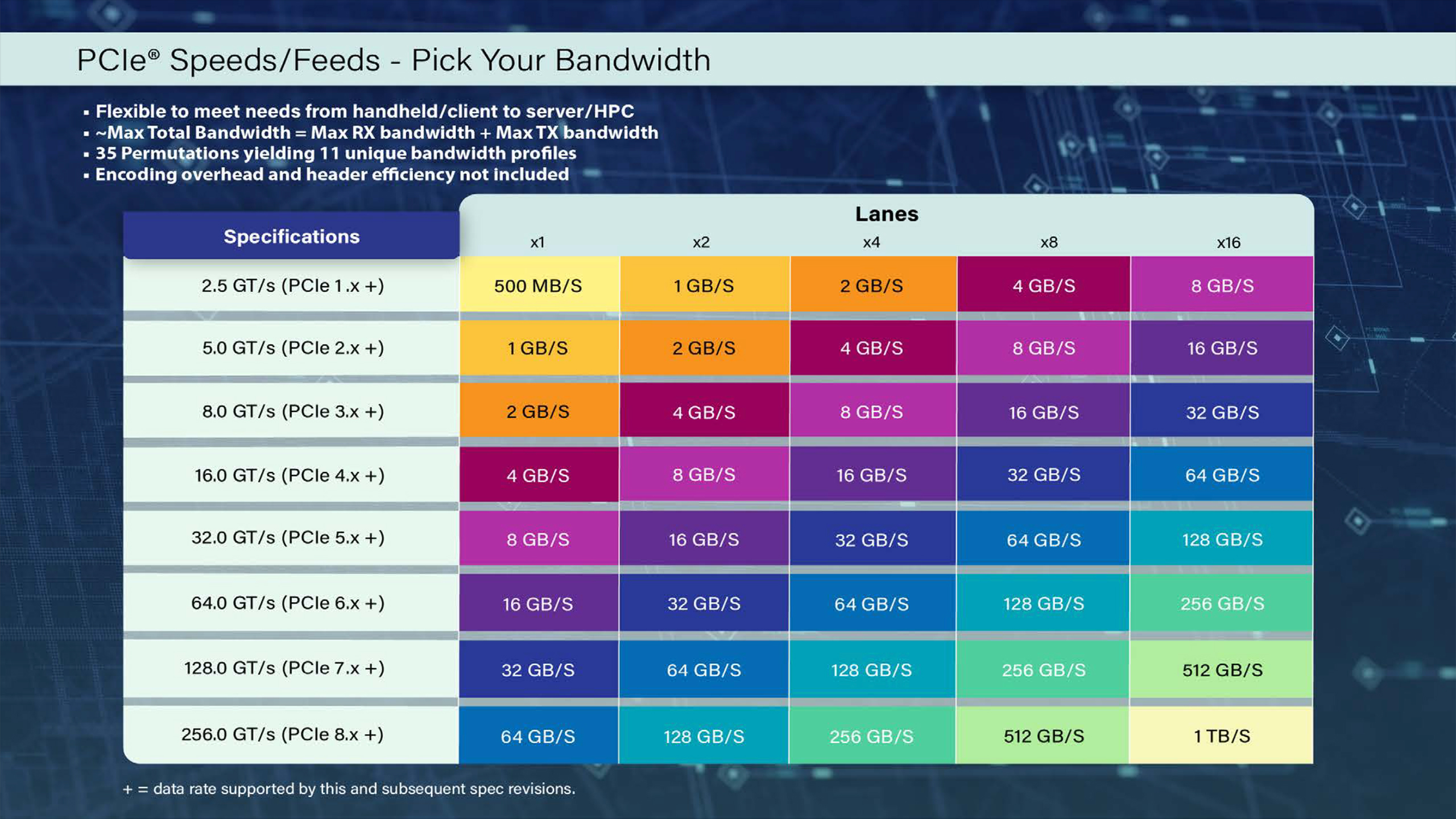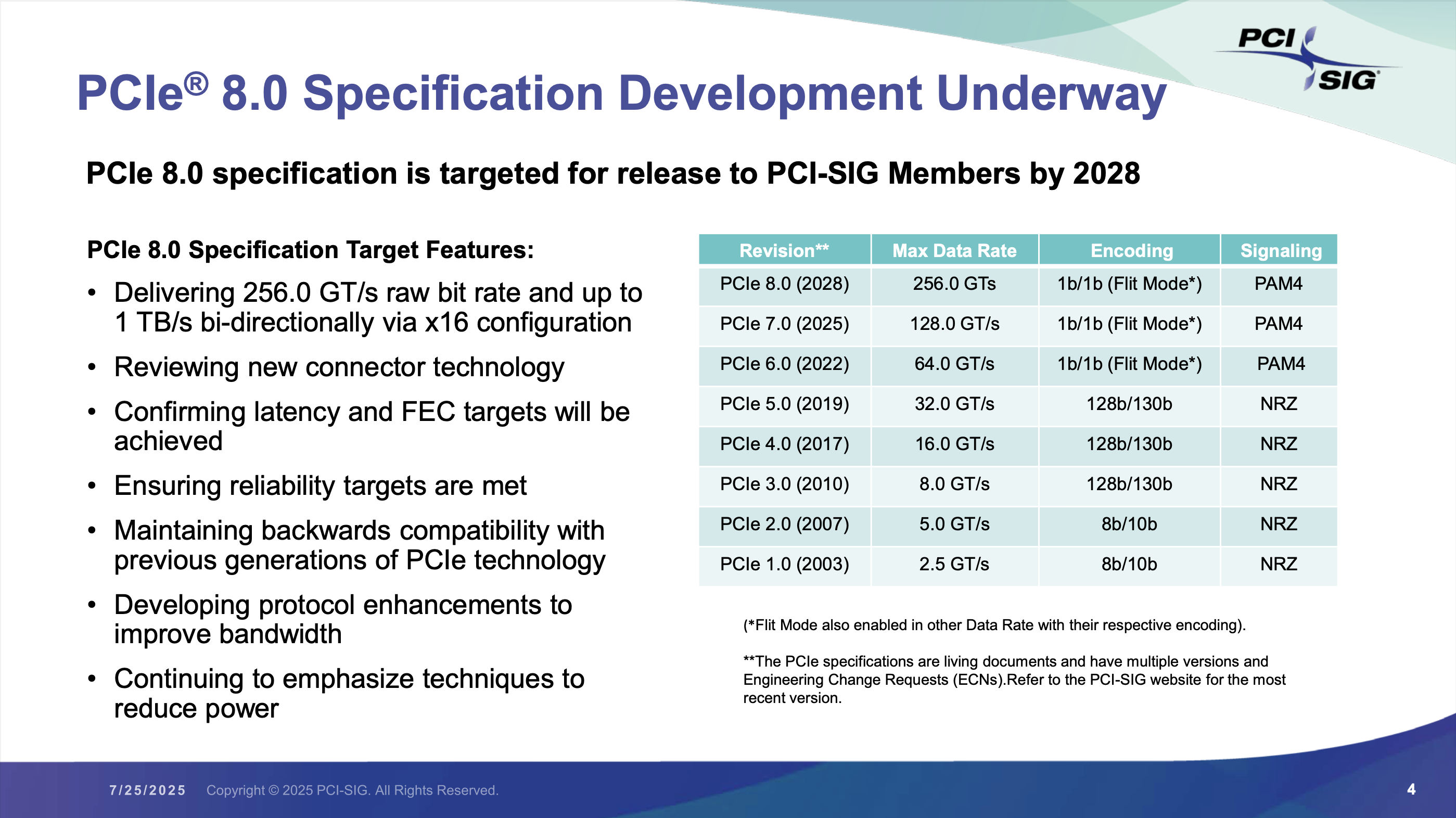PCI-SIG announces PCIe 8.0 spec with twice the bandwidth — 1TB/s of peak bandwidth, 256 GT/s per lane, and a possible new connector
Fast. Furious. Copper?

The PCI-SIG consortium has officially announced the development of the PCI Express 8.0 specification. This new version is set to double data transfer rate to 256 GT/s per lane. In addition to the extra bandwidth, PCIe Gen8 is said to feature protocol enhancements to increase real-world bandwidth and reduce power consumption.
The upcoming PCIe 8.0 specification will double the raw bit rate of PCIe 7.0 to 256.0 GT/s, enabling up to 1 TB/s of bi-directional bandwidth across a x16 configuration. The spec will continue to rely on PAM4 signaling with forward error correction (FEC) and Flit Mode encoding, which have been used with PCIe 6.0 and PCIe 7.0. However, hitting 256 GT/s per lane will likely be an incredibly difficult task. Engineers will enter uncharted territory, as no current copper interconnect standard can boast such a data transfer rate, especially over distances of tens of centimeters.
To ensure reliability, a usable signal-to-noise ratio, consistent performance, acceptable signal loss, signal integrity, and power efficiency for PCIe 8.0 interconnections, PCI-SIG is now reviewing a new interconnection technology while maintaining backwards compatibility with previous-generation PCIe implementations. The specification is also set to introduce protocol enhancements to optimize bandwidth use, and methods to improve power efficiency.
PCI-SIG's release does not explicitly say whether all PCIe Gen 8 implementations will continue to rely on copper, though backwards compatibility implies plans to continue using copper interconnects. At 256 GT/s over copper, designers face extreme signal integrity challenges, length constraints, and a heavy dependency on materials, equalization, retimers or alternative transmission methods.
These issues are pushing the industry toward optical interconnects and advanced packaging (like co-packaged optics or chiplets with short-reach links) for future high-speed systems. These needs are why PCI-SIG has issued optical-aware retimer specifications for PCIe 6.4 and 7.0, which will likely extend to PCIe 8.0.
"Following this year's release of the PCIe 7.0 specification, PCI-SIG is excited to announce that the PCIe 8.0 specification will double the data rate to 256 GT/s, maintaining our tradition of doubling bandwidth every three years to support next-generation applications," said Al Yanes, PCI-SIG President and Chairperson. "With the increasing data throughput required in AI and other applications, there remains a strong demand for high performance. PCIe technology will continue to deliver a cost-effective, high-bandwidth, and low-latency I/O interconnect to meet industry needs."
As is usual with the recent generations of PCIe announcements, PCI-SIG positions its next-generation interconnection technology primarily for high-end, bandwidth-hungry applications like AI servers and data centers, HPC workloads, hyperscale cloud service providers, and automotive, aerospace and military solutions. While client PCs might eventually adopt PCIe 8.0, timelines for such applications will likely extend well into 2030s at the earliest.
Get Tom's Hardware's best news and in-depth reviews, straight to your inbox.
Follow Tom's Hardware on Google News to get our up-to-date news, analysis, and reviews in your feeds. Make sure to click the Follow button.

Anton Shilov is a contributing writer at Tom’s Hardware. Over the past couple of decades, he has covered everything from CPUs and GPUs to supercomputers and from modern process technologies and latest fab tools to high-tech industry trends.
-
Jame5 I know it's an extra cost, but what about optical between the controller and the slot? It's only a few inches replaced, but it would help.Reply -
chaz_music Even with PAM4, this is solidly in high frequency RF signaling. This might be the end of backwards compatible PCIe slots. I could see a connector scheme with shielded coaxial interconnects, or as others said using optical instead of RF over copper.Reply -
bit_user Reply
For the love of... !The article said:The upcoming PCIe 8.0 specification will double the raw bit rate of PCIe 7.0 to 256.0 GT/s, enabling up to 1 TB/s of bi-directional bandwidth across a x16 configuration.
Please stop parroting this BS marketing number. The far more useful number is 512 GB/s. If someone has a PCIe 8.0 SSD on a x4 link, the bandwidth of the other direction will not help increase their read or write speeds! Okay, sure there are mixed workloads, but most are either predominantly reading or writing, and the numbers drive makers tout are certainly uni-directional numbers.
Most of the time, you're bottlenecked on one direction or the other. This is why the bandwidth usually quoted is the uni-directional speed, even in a full-duplex link. In gaming, nearly all the data transfer volume is from host -> GPU. The fact that the link is bidir and symmetrical is almost inconsequential.
For example, we say that Ethernet is 1 Gigabit or 10 Gigabit. Just because it happens to (normally) be full-duplex, we don't then say it's 2 Gigabit or 20 Gigabit!
@Paul Alcorn Can the new Toms Hardware please add this to your style guide?
: ) -
bit_user Reply
I can't find the articles, but IIRC there's both a working group for routing existing PCIe signals over optical links and another working group exploring post-PCIe optical interconnects.Jame5 said:I know it's an extra cost, but what about optical between the controller and the slot? It's only a few inches replaced, but it would help.
Here's a proprietary effort at routing standard PCIe 7.0 over optical:
https://www.tomshardware.com/tech-industry/optical-pcie-70-connection-hits-a-blazing-128-gts -
bit_user Reply
Even if it's the only option? There might be no way to meet the electrical requirements of PCIe 8.0 with the existing connector.logainofhades said:Not sure we should trust them with a new connector
Just because it's PCIe doesn't mean we need to have the same edge connector we know and love(?). M.2 and U.2 are two examples of PCIe signals using different connectors. The fact that the signal is exactly the same means you can do weird hacks, like mounting M.2 SSDs on a cheap PCIe add-in card or even having a M.2 board that can host a PCIe add-in card. -
bit_user Reply
To be fair, that was only on B650 boards. Many other B650 boards never even gave you the option to enable PCIe 5.0, such as an ASUS board I have.S58_is_the_goat said:Gigabyte: best we can do is pcie4... -
logainofhades ReplyS58_is_the_goat said:Gigabyte: best we can do is pcie4...
99% of all PC users don't need more than that, and many of those don't even need Gen 4.
Even a SATA ssd is fast enough for general PC usage.
